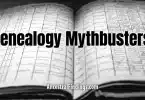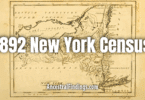Most of the 1890 U.S. Federal Census was destroyed in a fire in the 1930’s. This leaves a large, annoying 20-year gap in census records for genealogists. As any genealogist knows, a lot of things can happen in families in 20 years. It is enough time for a child to be born, grow up, get married, and move away from home, and have a child of their own. The family could move, possibly many times. Lots of other things can happen in that time, and the absence of the 1890 census represents a significant loss of family knowledge for people with ancestors in America between 1880 and 1900 when the prior and next censuses were taken. Because so many genealogists rely on the census to point them in the direction of further research sources, it might seem like there are no other records to tell them what was going on in their family in that 20-year gap. The good news is that this isn’t true. There are other sources of information available to you that can fill in this missing information. Here are five of them you should definitely be using.
1. State Census Records
Many states took their own censuses in between the federal ones. While not every state has a state census, enough of them do that there is a good chance at least one branch of your family will appear in one. Mos state census records were done in years ending in the number 5, which is the mid-point from one federal census to another. However, some state censuses will appear at other years ending in different numbers.
Look at your state archives, or such well-known genealogy websites as FamilySearch.org (free) and Ancestry.com (paid). Both of these sites have large, indexed collections of state census records. Some states even have more than one state census. Look for state census records taken between 1880 and 1900. If you find your ancestors in them, it may answer a lot of unanswered questions from the gap in the federal census.
2. State Vital Records
Different states began taking vital records and recording them at the state level as a matter of law at different times. However, most states required it by the early 1900’s. Check the states where your ancestors lived and see if those states had mandatory birth, death, and marriage certificate record laws during the 1880 to 1900 gap years. If they do, then start looking for records with the names of people you already know in them. This will fill in missing birth, death, and marriage information, and will also give you ideas for where to look for further research sources.
3. Old Newspaper Records
Many old newspapers were preserved in archives, and lots of those newspapers are available online on sites like GenealogyBank.com and Ancestry.com (both paid sites). There is even a paid site called NewspaperArchives.com that has a huge collection of old newspapers and nothing else. If you can’t find the newspapers you need online, check with the office of that newspaper and see how far back their archives go, and if someone can search them for you, or if you can search them on-site if you visit there. Look for mentions of your ancestors between the years 1880 and 1900. You stand an excellent chance of finding out all kinds of interesting things about your family.
4. Military Records
If you have ancestors who fought in the Civil War or the Spanish-American War, you may be able to find out things about them that would have been on the 1890 census in their military records. These records include their service records and pension (or widow’s pension) applications. Lots of detailed family information was often recorded in these records, especially in the pension applications. Look for them on Fold3.com, Ancestry.com, and with the National Archives.
5. Cemetery Records
Family members were (and are) often buried next to or near each other. If you know of a cemetery where an ancestor from the late 1800’s is buried, look at the records from that cemetery to discover who is buried nearby. If the cemetery has an office, ask for a burial map, as it will list the names of unmarked burials and show you their location. You can also use the free website, FindAGrave.com, to do this kind of research to some extent. Doing this will give you the ability to discover the previously unknown death dates of ancestors you may have been searching for, and will also show you previously unknown relatives, such as children who were born and died in the gap between the U.S. census records.






